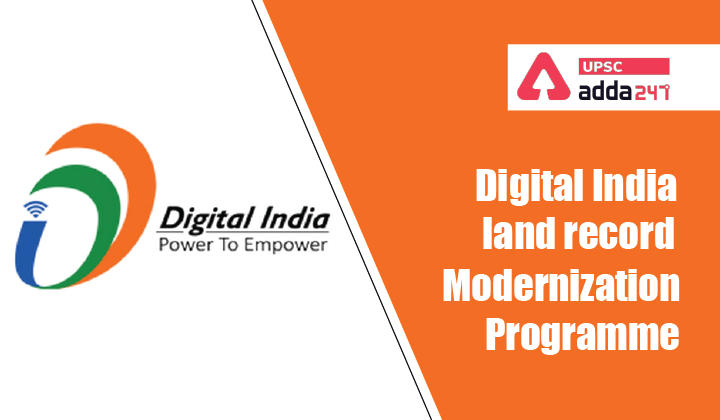Table of Contents
Digital India Land Record Modernisation Programme: Relevance
- GS 2: Important aspects of governance, transparency and accountability, e-governance- applications, models, successes, limitations, and potential.
Digital India Land Record Modernisation Programme: Context
- Recently, Ministry of Rural Development has inaugurated ‘Bhumi Samvaad’ – National Workshop on Digital India Land Record Modernisation Programme (DILRMP) at India Habitat Centre.
Digital India Land Record Modernisation Programme: Key points
- States have been suggested to learn and adopt the best practices of other states in the field of land management, land acquisition and infrastructure projects.
- MoRD has also launched National Generic Document Registration System (NGDRS) portal and Dashboard.
Unique Land Parcel Identification Numbers (ULPIN)
- It is just like the Aadhar Number of land parcels.
- Under this, a unique ID based on Geo-coordinates of the parcels is generated and assigned to the plots.
- This has been introduced to share the computerized digital land record data among different States/Sectors and a uniform system of assigning a unique ID to the land parcel across the country.
- So far it has already been implemented in 13 States and pilot tested in another 6 States.
- It has been decided to complete the process of assigning unique IDs to the land parcels in the entire country by the end of this financial year, (FY 2021-22).
Development of National Generic Document Registration System (NGDRS)
- NGDRS is an in-house advanced software application for the registration system developed by NIC.
- This software application is scalable, flexible, configurable and compatible with the state-specific needs in the country.
- It ensures transparency, accountability of the officials executing the documents and reduction in cost, time and number of visits and procedures required for the execution of the registration documents.
- So far, it has already been implemented in 12 States and pilot tested in 3 States covering more than 10 crore population.
Digital India Land Record Modernisation Programme
- In 2008, two Centrally Sponsored Schemes viz.: Computerisation of Land Records (CLR) & Strengthening of Revenue Administration and Updating of Land Records (SRA&ULR) merged into a modified Scheme named Digital India Land Records Modernization Programme (DILRMP).
DILRMP Objective
- The main aims of DILRMP are to usher in a system of updated land records, automated and automatic mutation, integration between textual and spatial records, inter-connectivity between revenue and registration, to replace the present deeds registration and presumptive title system with that of conclusive titling with title guarantee.
DILRMP Components
The DILRMP has 3 major components
- Computerization of land record
- Survey/re-survey
- Computerization of Registration.
DILRMP Implementation
- The State Governments/UT Administrations will implement the programme with financial and technical supports from the Dept. of Land Resources, Ministry of Rural Government, GoI.
DILRMP benefits
- Real-time land ownership records will be available to the citizen
- Since the records will be placed on the websites with proper security IDs, property owners will have free access to their records without any compromise in regard to confidentiality of the information
- Free accessibility to the records will reduce interface between the citizen and the Government functionaries, thereby reducing rent seeking and harassment.
- Public-private partnership (PPP) mode of service delivery will further reduce citizen interface with Govt. machinery, while adding to the convenience
- Abolition of stamp papers and payment of stamp duty and registration fees through banks, etc. will also reduce interface with the Registration machinery
- With the use of IT inter linkages; the time for obtaining RoRs, etc. will be drastically reduced
- The single-window service or the web-enabled “anytime-anywhere” access will save the citizen time and effort in obtaining RoRs, etc.
- Automatic and automated mutations will significantly reduce the scope of fraudulent property deals
- Conclusive titling will also significantly reduce litigation
- These records will be tamper-proof
- This method will permit e-linkages to credit facilities
- Market value information will be available on the website to the citizen
- Certificates based on land data (e.g., domicile, caste, income, etc.) will be available to the citizen through computers
- Information on eligibility for Government programs will be available, based on the data
- Issuance of land passbooks with relevant information will be facilitated
Also Read:
| Legislative Council: A Complete Analysis | MSME Definition Expanded: Know Everything About MSME | Mineral Conservation and Development (Amendment) Rules, 2021 | Nutrition Smart Villages |
| UN Report on Internal Migration | Combating Hidden Hunger: Rice Fortification | Global Hunger Index 2021 | SITMEX Exercise-21 |
| Unlawful Activities (Prevention) Act (UAPA), 1967 | Financial Stability Report | Impact of US Inflation in India | Freight Smart Cities: Logistics Issues and Government Steps |
| India Rejects WTO Draft on Fishery Subsidy | Project BOLD and Importance of Bamboo in India | ADR Report on Political Donations | Delhi Declaration on Afghanistan |



 TSPSC Group 1 Question Paper 2024, Downl...
TSPSC Group 1 Question Paper 2024, Downl...
 TSPSC Group 1 Answer key 2024 Out, Downl...
TSPSC Group 1 Answer key 2024 Out, Downl...
 UPSC Prelims 2024 Question Paper, Downlo...
UPSC Prelims 2024 Question Paper, Downlo...
